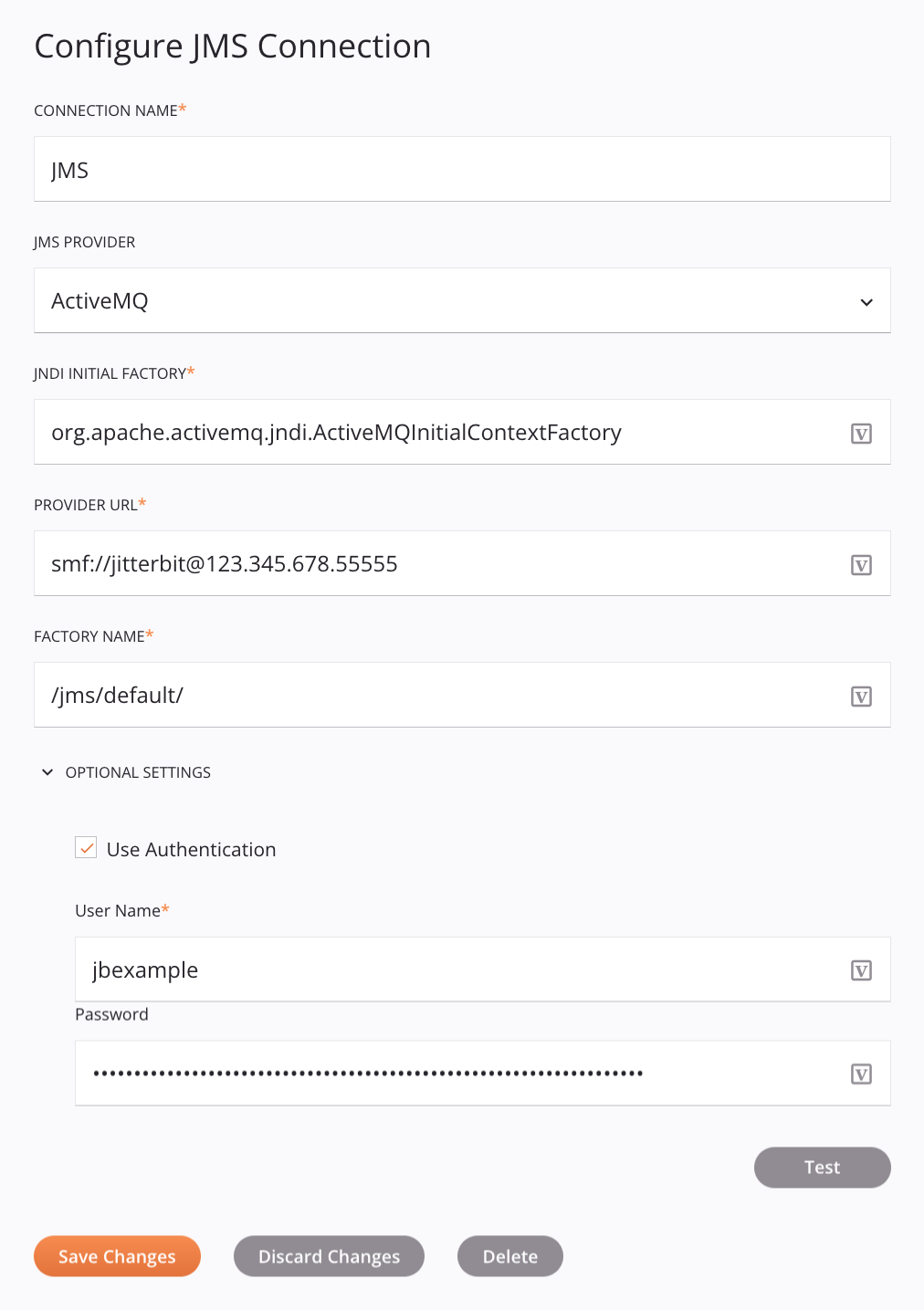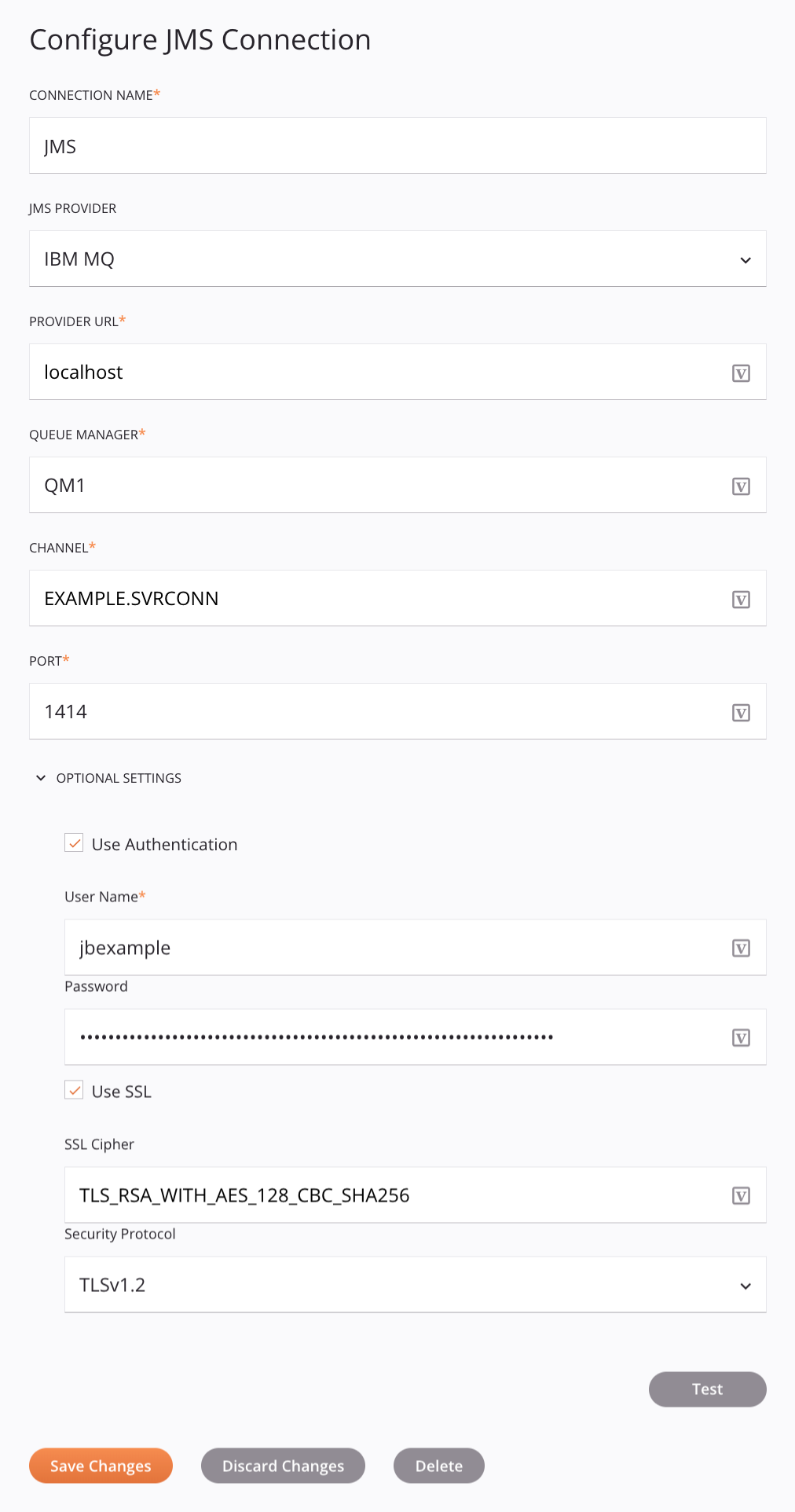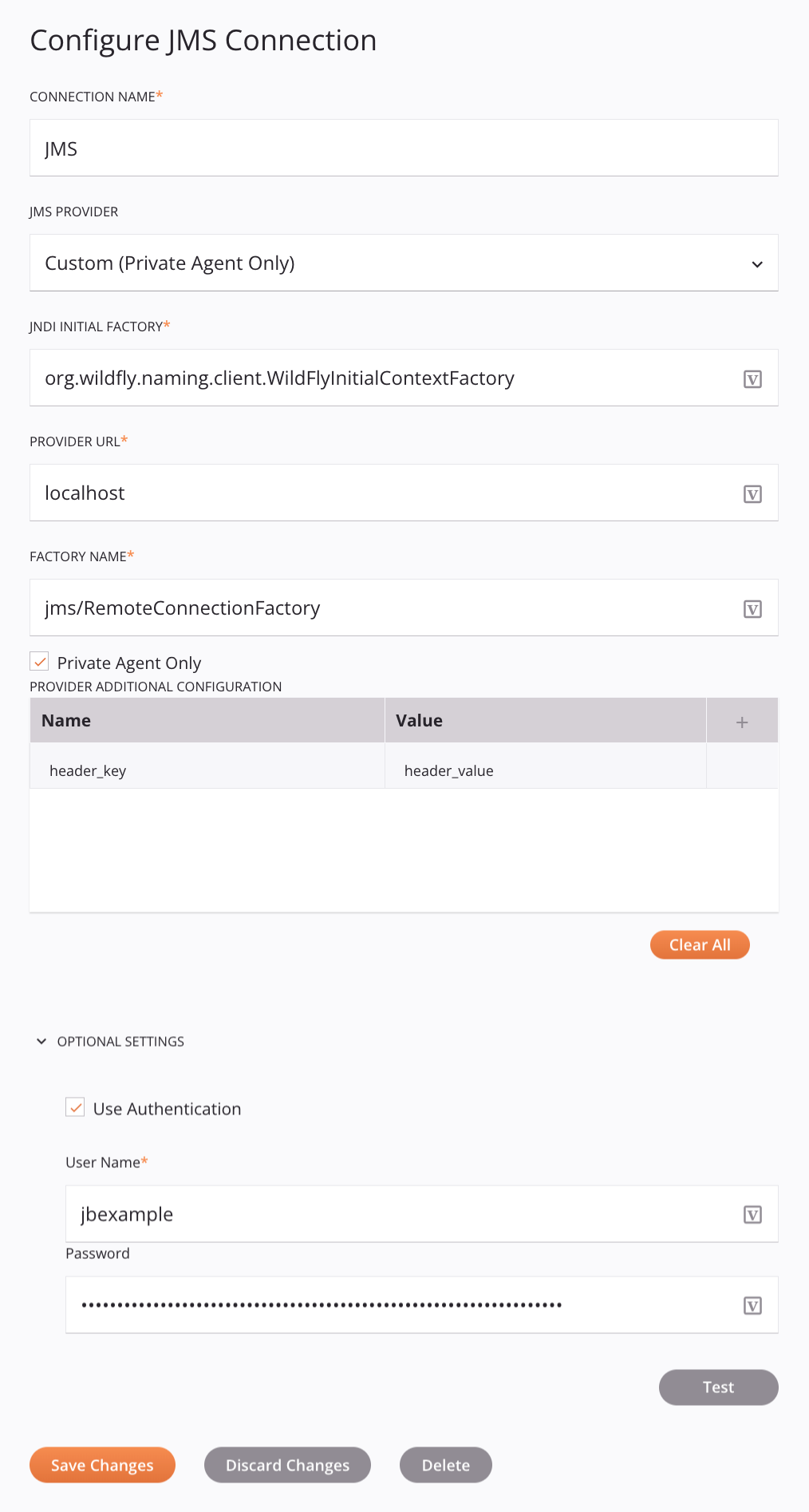JMS connection¶
Introduction¶
A JMS connection, created using the JMS connector, establishes access to JMS providers. Once a connection is configured, you can create instances of JMS activities associated with that connection to be used either as sources (to provide data in an operation) or as targets (to consume data in an operation).
Note
This connector supports the Enable Re-authentication on Change organization policy. If enabled, a change to the Factory Name or Username in this connection requires users to re-enter the Password for the connection.
Create or edit a JMS connection¶
A new JMS connection is created using the JMS connector from one of these locations:
- The design component palette's Project endpoints and connectors tab (see Design component palette).
- The Global Connections page (see Create a global connection in Global Connections).
An existing JMS connection can be edited from these locations:
- The design component palette's Project endpoints and connectors tab (see Design component palette).
- The project pane's Components tab (see Component actions menu in Project pane Components tab).
- The Global Connections page (see Edit a global connection in Global Connections).
Configure a JMS connection¶
Each user interface element of the JMS connection configuration screen is described below.
The interface used in the JMS connection configuration depends on the JMS Provider selected:
Active mq¶
When Active MQ is selected as the JMS Provider this interface is presented:

Tip
Fields with a variable icon ![]() support using global variables, project variables, and Jitterbit variables. Begin either by typing an open square bracket
support using global variables, project variables, and Jitterbit variables. Begin either by typing an open square bracket [ into the field or by clicking the variable icon to display a list of the existing variables to choose from.
-
Connection Name: Enter a name to use to identify the connection. The name must be unique for each JMS connection and must not contain forward slashes
/or colons:. This name is also used to identify the JMS endpoint, which refers to both a specific connection and its activities. -
JMS Provider: From the menu, select Active MQ.
-
JNDI Initial Factory: Enter the JNDI (Java Naming and Directory Interface) initial factory.
-
Provider URL: Enter the connection URL to be used.
-
Factory Name: Enter the connection factory name.
-
Optional Settings: Click to expand an additional optional setting:
-
Use Authentication: Select to authenticate the connection using basic authentication. When selected, these fields become available:
-
Username: Enter the username for the JMS provider.
-
Password: Enter the password for the JMS provider.
Note
To use SSL/TLS authentication with ActiveMQ, SSL must be configured for the JMS client and a certificate must be added to the Jitterbit Java keystore (as described in prerequisites). Once the prerequisites have been met, the connection will automatically use SSL/TLS authentication. To discontinue SSL/TLS authentication, you must remove the certificate from the Jitterbit Java keystore.
-
-
-
Password: Enter the password for the JMS provider.
-
Test: Click to verify the connection using the provided configuration. When the connection is tested, the latest version of the connector is downloaded by the agent(s) in the agent group associated with the current environment. This connector supports suspending the download of the latest connector version by using the Disable Auto Connector Update organization policy.
-
Save Changes: Click to save and close the connection configuration.
-
Discard Changes: After making changes to a new or existing configuration, click to close the configuration without saving. A message asks you to confirm that you want to discard changes.
-
Delete: After opening an existing connection configuration, click to permanently delete the connection from the project and close the configuration (see Component dependencies, deletion, and removal). A message asks you to confirm that you want to delete the connection.
IBM MQ¶
Note
IBM MQ requires and can be used only on a Harmony private agent. IBM MQ 9.2 is supported. Other versions of IBM MQ may also work but have not been tested by Jitterbit.
When IBM MQ is selected as the JMS Provider this interface is presented:

Tip
Fields with a variable icon ![]() support using global variables, project variables, and Jitterbit variables. Begin either by typing an open square bracket
support using global variables, project variables, and Jitterbit variables. Begin either by typing an open square bracket [ into the field or by clicking the variable icon to display a list of the existing variables to choose from.
-
Connection Name: Enter a name to use to identify the connection. The name must be unique for each JMS connection and must not contain forward slashes
/or colons:. This name is also used to identify the JMS endpoint, which refers to both a specific connection and its activities. -
JMS Provider: From the menu, select IBM MQ.
-
Provider URL: Enter the connection URL to be used.
-
Queue Manager: Enter the name of the queue manager.
-
Channel: Enter the channel connected to the specified queue manager.
-
Port: Enter the port that the channel is connected to.
-
Optional Settings: Click to expand additional optional settings:
-
Use Authentication: Select to authenticate the connection using basic authentication. When selected, these fields become available:
-
Username: Enter the username for the JMS provider.
-
Password: Enter the password for the JMS provider.
-
-
Use SSL: Select to authenticate the connection using client Secure Sockets Layer (SSL). When selected, these fields become available:
Important
When using this option, SSL must be configured for the JMS client and a certificate must be added to the Jitterbit Java keystore (as described in prerequisites).
-
SSL Cipher: Enter the SSL CipherSpec. For more information on IBM MQ CipherSpecs, see the IBM MQ documentation.
-
Security Protocol: From the menu, select the security protocol to use, one of TLS, TLSv1.0, TLSv1.1, or TLSv1.2. For more information, see the IBM MQ documentation.
-
-
-
Test: Click to verify the connection using the provided configuration. When the connection is tested, the latest version of the connector is downloaded by the agent(s) in the agent group associated with the current environment. This connector supports suspending the download of the latest connector version by using the Disable Auto Connector Update organization policy.
-
Save Changes: Click to save and close the connection configuration.
-
Discard Changes: After making changes to a new or existing configuration, click to close the configuration without saving. A message asks you to confirm that you want to discard changes.
-
Delete: After opening an existing connection configuration, click to permanently delete the connection from the project and close the configuration (see Component dependencies, deletion, and removal). A message asks you to confirm that you want to delete the connection.
Custom¶
Note
This option allows you to establish access to other JMS providers. Using this option requires the use of a private agent and additional configuration steps, as described in Configure additional providers.
When Custom (Private Agent Only) is selected as the JMS Provider this interface is presented:

-
Connection Name: Enter a name to use to identify the connection. The name must be unique for each JMS connection and must not contain forward slashes
/or colons:. This name is also used to identify the JMS endpoint, which refers to both a specific connection and its activities. -
JMS Provider: From the menu, select Custom (Private Agent Only).
Note
This option has been confirmed to work with the JBoss EAP, Oracle WebLogic, and GlassFish JMS providers. Other JMS providers are expected to work, but have not been tested by Jitterbit.
-
JNDI Initial Factory: Enter the JNDI (Java Naming and Directory Interface) initial factory.
-
Provider URL: Enter the connection URL to be used.
-
Factory Name: Enter the connection factory name.
-
Private Agent Only: When selected, shows the Provider Additional Configuration table, which is used to add additional configuration properties as key-value pairs.
Click the add icon
 to add a row to the table below and enter a key-value pair for each property.
to add a row to the table below and enter a key-value pair for each property.To save the row, click the submit icon
 in the rightmost column.
in the rightmost column.To edit or delete a single row, hover over the rightmost column and use the edit icon
 or delete icon
or delete icon  .
.To delete all rows, click Clear All.
Important
Fields in the Provider Additional Configuration table display the variable icon
 only in edit mode. For these fields' variable values to be populated at runtime, the agent version must be at least 10.75 / 11.13.
only in edit mode. For these fields' variable values to be populated at runtime, the agent version must be at least 10.75 / 11.13. -
Optional Settings: Click to expand an additional optional setting:
-
Use Authentication: Select to authenticate the connection using basic authentication. When selected, these fields become available:
-
Username: Enter the username for the JMS provider.
-
Password: Enter the password for the JMS provider.
-
-
-
Test: Click to verify the connection using the provided configuration. When the connection is tested, the latest version of the connector is downloaded by the agent(s) in the agent group associated with the current environment. This connector supports suspending the download of the latest connector version by using the Disable Auto Connector Update organization policy.
-
Save Changes: Click to save and close the connection configuration.
-
Discard Changes: After making changes to a new or existing configuration, click to close the configuration without saving. A message asks you to confirm that you want to discard changes.
-
Delete: After opening an existing connection configuration, click to permanently delete the connection from the project and close the configuration (see Component dependencies, deletion, and removal). A message asks you to confirm that you want to delete the connection.
Next steps¶
After a JMS connection has been created, you place an activity type on the design canvas to create activity instances to be used either as sources (to provide data in an operation) or as targets (to consume data in an operation).
Menu actions for a connection and its activity types are accessible from the project pane and design component palette. For details, see Actions menus in Connector basics.
These activity types are available:
-
Acknowledge: Sends a bulk acknowledgment of JMS messages and is intended to be used as a target in an operation.
-
Get: Retrieves all JMS messages available in a specific queue and is intended to be used as a source in an operation.
-
Consume: Consumes messages from a JMS queue and is intended to be used as a source in an operation.
-
Send: Sends messages to a JMS queue or topic and is intended to be used as a target in an operation.